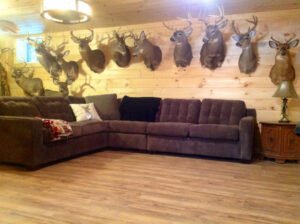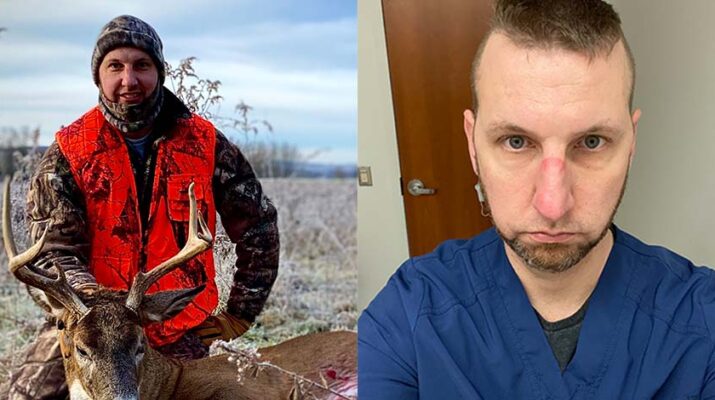Jason Paulisczak works as a travel RN at Mercy Hospital. He says that hobbies that energize and renew him help him provide better care to patients
By Deborah Jeanne Sergeant
Surprise! Nurses are real people behind their masks and scrubs.
Carving out time to pursue a hobby can help them beat burnout and promote self-care.
Some nurses enjoy hobbies that are a bit more unusual than others.

Performing taxidermy is the way Jason Paulisczak relaxes from his work as a travel RN for Medical Solutions, fulfilling a contract at Mercy Hospital. He is a bachelor’s degreed, board-certified nurse.
Paulisczak grew up in suburban Buffalo and moved to Odessa, near Watkins Glen, 22 years ago as a new RN. He decided he needed a hobby that would help him stay refreshed as a nurse and that would fit in with his rural environment. Many neighbors hunted, so he decided to follow suit.
“I’d always been interested in hunting but I grew up in a non-hunting family,” he said.
Typically, hunters learn from relatives about outdoor life and hunting.
Paulisczak had to learn on his own from books, videos and trial-and-error until a few local mentors taught him about wildlife and how to be an outdoorsman.
“I studied deer and did a lot of research on their habits,” Paulisczak said.
“It was good way to occupy myself. I put my effort into hunting and becoming an outdoorsman.”
He hunts on his own 10 acres and neighbors’ land.
As he learned more about hunting, he approached the hobby with a conservation angle. He let younger bucks go so they could mature more and strove to promote deer healthy by planting chicory and clover as healthful fodder throughout the year.
Once he began harvesting surplus wildlife—an important part of environmental conservation, he said—he had a few animals professionally mounted. That can cost more than $2,500 for an entire deer or $525 for a “shoulder mount” style. This includes the deer’s head down to its shoulders. In 2008, Paulisczak asked taxidermist Howard Leiphen in New Field if he could learn from him.
“He’d said he’d love to,” Paulisczak said. “He passed on his knowledge of taxidermy. We’d help each other out through the years. If he needed a cape, I’d get it for him.”
A deer cape is a deer hide from the animal’s nose to the area just behind its shoulders. The pair worked together for several years until Leiphen retired. Paulisczak began performing taxidermy work for other hunters.
The process involves cleaning and tanning the hide as part of preserving it—an all-day process from start to finish.
When he began working as a traveling nurse, he cut back his taxidermy side gig because oftentimes he was not home long enough to complete the process. He still mounts specimens for friends and for himself. His trophy room boasts 18 deer heads, three full body deer, several “European mounts” (just the deer’s skull and antlers), four coyotes, a porcupine, a snapping turtle, a fisher, squirrels, rabbits, foxes, two bobcats, various birds and—believe it or not—two skunks.
“I was quilled multiple times doing the porcupine,” Paulisczak said. “I kept the pliers handy to pull them out. The underbelly has no quills so you skin from underneath. Doing skunks is not good. No more skunks—ever. The last time I bought one home, I wrapped it in five garbage bags and put in the freezer. The smell permeated the house by 5 a.m.”
Once mounted, the animal is de-scented. Various professional products helped him get rid of the odor of the specimens.
While a taxidermy hobby may seem strange or even macabre to some, it represents the results of some of his most enjoyable leisure time: hours sitting quietly in nature.
“Being outside is really therapeutic,” Paulisczak said. “Spending time in the woods is therapeutic for me. I ride my horse in the woods, which I enjoy. Seeing the animals and when you do taxidermy, you’re bringing that animal back to life in a sense. The biggest compliment is that the animal looks alive.”
He believes that hobbies that energize and renew him help him provide better care to patients.
In addition to the horses, he has a Dalmatian and keeps a few farm animals as pets, including a turkey and six goats. His menagerie and taxidermy hobby often provides a means of connecting with patients.
“You build a rapport,” he said. “Some talk about hunting and we have conversations about deer hunting as that’s most common. You have to know your audience; some don’t appreciate it. As a nurse, it’s very important to build rapport and trust and get to know them on a personal level as they can feel they trust you. It’s a better patient-nurse relationship if they know a little bit about you.”
Featured images: Jason Paulisczak works at Mercy Hospital as a travel nurse. In his spare time, he likes deer hunting. He learned from a professional taxidermist how to mount animals, which he often does for friends.

